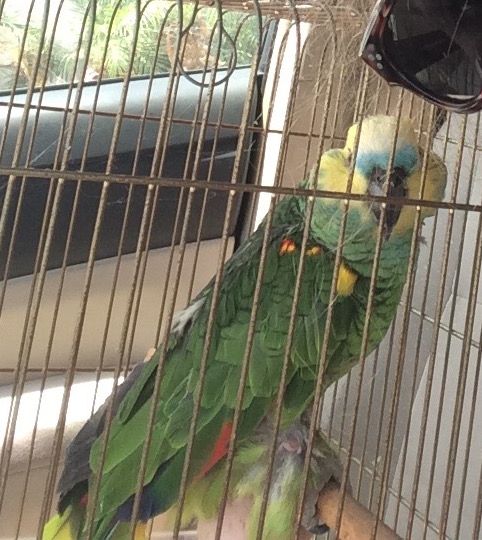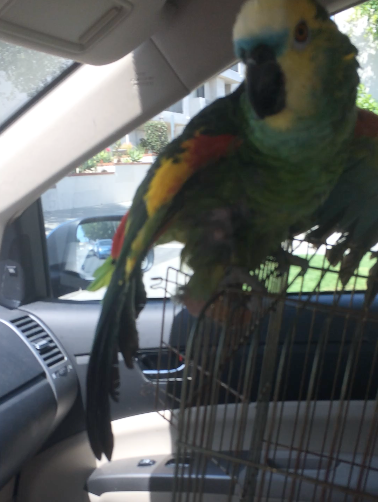Yes, Yellow-Wing Amazons are a sub-species of the Blue-Fronted Amazon (common) Family. Having said that, they are far-enough removed that it is not recommended that they are crossbreed with the Blue-Fronted (common) as deformities would be common. Once upon a time, there was an Amazon Society in the USA that was an out-growth of the primary group in England (still active). The classification defined below was and is still use to set and define the separation between the two parrots. The Blue-Fronted (common) will not meet the classification provided below.
Rejoice in the fact that you have a Yellow-Wing Amazon.
Common Name: Blue-Fronted Amazon (Genus Amazona)
Sub-species: Amazona aestiva xantopteryx (Yellow-Wing)
Full Common Name: Blue-Fronted, Yellow-Wing Amazon (Genus Amazona aetiva xantopteryx)
Know Common Name: Yellow-Wing Amazon
Color: Deeper grass green with darker (black) scolloping at the end. Common (red & deep blue to purple) display (flash) feathers on tail and wings
Breast: Yellow-green with slight (black) scalloping at the end
Forehead: Slight line (1/8 - 1/4" with splashes) of turquoise along the top and sides of the Cere (nostril area)
Head Feathering: Behind turquoise frontal feathers, a sizable area of creamy-white yellow merges into green. Pale yellow continues around both eyes and onto the cheeks, extending to the base of the lower beck. Under the beak (bib area) there is a slight line of turquoise-green, which quickly transfers into the yellow-green of the Breast. Green head feathers are scalloped with black and carry down the back of the neck and both sides. Tiny splashes of turquoise occur within and border the creamy-white yellow feathering.
Cere, Nostrils & Beak: Dark gray to black Mouth & Tongue: Black
Bend of Wing: Solid bright red wing edge with streamers (as if applied by an air brush) from body to bend of wing with bright buttercup yellow (with tiny splashes of red) on the bend extending onto wing (approximately the size of a quarter).
Carpal Edge: Yellow-green
Legs & Feet: Longer legs than common, gray to dark black toenails and yellow-green feathers on upper leg with yellow 'leg-lets' at feather base and inside .
General shape: Longer, slimmer, larger than common with greater wingspan and long tail.
Character, Expression & Vocalization: Not so strong willed as common, can appear with an aloof/surprised expression. Generally quiet calls and speech, but will produce very loud calls
NOTE #1: BFA are more common in Northern South America whereas YWA are more central/southern South America beyond where the jungle transitions into more open forested areas. Areas that longer body and larger wings and tail work in the open forests and plains. Yellow-wing Amazons evolved from Blue Front Amazons to better meet the needs of this more open area.
NOTE #2: The cover page of Sally Blanchard's Companion Amazon Handbook features her drawing of 'Darby' our Yellow-Wing Amazon.
Set a Blue-Fronted (common) next to a Yellow-Wing and the difference is very clear.
Ultimately, they are not the same!
Importers found that by simply using the 'common' name (Blue-Fronted), they could import Yellow-Wings and get around additional paperwork.
Why is any of this important. Simple. At present, there is likely more Yellow-Wings in North America then in their natural region: South/Central South America. As that population continues to declines, North America becomes the source. Clarity in the North American population becomes more important.
Maintaining the clarity of what Amazons are in North America becomes more important every year as the root population is Central and South America decline. It Is Important to clearly define and use their proper names.



 I'm more worried about his ears right now though. I want him to survive it! I'm afraid something else might be going on!
I'm more worried about his ears right now though. I want him to survive it! I'm afraid something else might be going on!


 I'm more worried about his ears right now though. I want him to survive it! I'm afraid something else might be going on!
I'm more worried about his ears right now though. I want him to survive it! I'm afraid something else might be going on!
